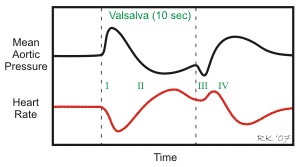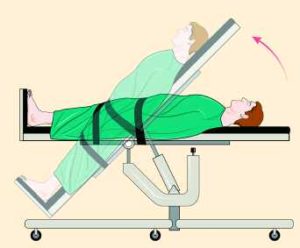When you suspect you may have P.O.T.S there are a variety of tests that your general physician or cardiologist can run to confirm the diagnosis. While there are a multitude of tests to confirm autonomic dysfunction—including bowel motility tests, sweat tests, urine-sodium level testing, and the cold pressor test—the most precise test for how autonomic dysfunction is affecting the heart are listed below:
The Tilt Table Test
The most commonly used test to diagnosis P.O.T.S. is the Tilt Table Test. This test involves a patient being strapped into a specially made inversion table which will tilt them upright, generally to angle of about 60 degrees. The patient, who will be lying flat, will have their blood pressure and heart rate monitored. The patient is then evaluated for their response upon being tilted forward and backwards. Generally P.O.T.S. patients who are not currently under the influence of beta blockers will have a poor reaction to this test and become visually distressed by nausea or fainting, This test can also be done in conjunction with a transcranial doppler ultrasonography which can detect a reduction in cerebral blood flow.
The Valsalva Maneuver
 Another option for testing if P.O.T.S. is a factor in a patient’s poor health is the use of the Valsalva Maneuver. This is the forced exhalation against a closed glattus. By blowing into a small tube and increasing the intrathorassic pressure, impeding venous return to the heart, the blood pressure will drop and the pulse will rise. However, for a patient with P.O.T.S. the blood pressure will drop—but does not come back up. The pulse will often rise considerably as well. This paradoxical response is indicative of an abnormal autonomic response to a sudden decrease in autonomic return.
Another option for testing if P.O.T.S. is a factor in a patient’s poor health is the use of the Valsalva Maneuver. This is the forced exhalation against a closed glattus. By blowing into a small tube and increasing the intrathorassic pressure, impeding venous return to the heart, the blood pressure will drop and the pulse will rise. However, for a patient with P.O.T.S. the blood pressure will drop—but does not come back up. The pulse will often rise considerably as well. This paradoxical response is indicative of an abnormal autonomic response to a sudden decrease in autonomic return.
Exclusionary Diagnostics
Because P.O.T.S. is an excellent imitator of multiple diseases, exclusionary testing must be done to gain an exact diagnosis of the condition. Tests for conditions such as Addison’s Disease and other thyroid abnormalities, adrenal testing, hormone testing, blood tests for anemia, liver, kidney, heart and lung functions as well as the hyper thyroid, hypo thyroid and liver-kidney panel must be performed.
A Holter Monitor test may also be a great way to differentiate between P.O.T.S. (Sinus tachycardia) and Superventricular Tachycardia (Cardiac Rhythm Disorder.)
Where can patients go to get these tests performed?
Many of these tests can be performed by your general physician, cardiologist, or even an emergency room doctor. You may be sent to a separate testing facility with more specialized equipment for such a diagnostic process.
After a P.O.T.S. diagnosis is confirmed, is there anything else to test for?
Many diseases have been linked to P.O.T.S including Lyme Disease, Mast Cell Disease, Chronic Fatigue, Fibromyalgia, and Epstien Bar. Your physician should check for all of these related conditions.
